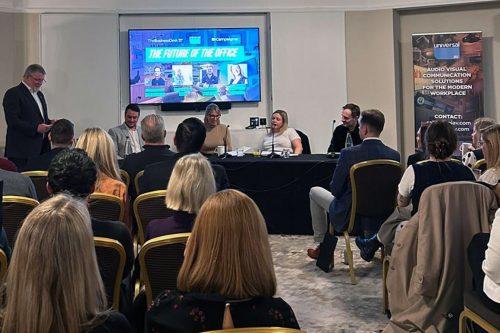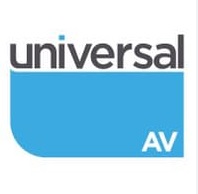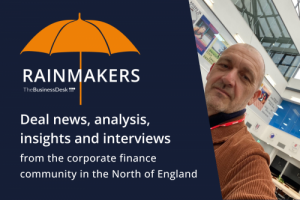Designing for productivity: how offices are changing to reflect changing work styles

Changing work patterns since the pandemic have forced a change in the way with use our offices – and even our attitudes to them.
A January survey of 1,000 people by tech retailer Currys showed only quarter of desk workers preferred working in the office, while 38% preferred hybrid working and 36% working from home. Across all three options, 58% of desk workers felt they were not productive in their current workplace.
At the Future of the Office seminar, sponsored by Universal AV, we brought together four experts in designing and running attractive modern offices to share their insights on how offices can cater for all these preferences – and enhance productivity.
Shelley Townend, marketing manager at Universal AV, which specialises in commercial audiovisual integration, highlighted the importance of offices as hubs. “The office is key,” she said. “You have a five-minute conversation which you just would not have if you were at home all the time. And the wealth of knowledge in offices is vital for the longevity of a business, as well as training people.”
But there is no one size fits all solution, said Matthew Toole, account manager with commercial interior design firm Design Tonic.
“The beautiful thing about it is that each business has a different dynamic,” he said. “Each business has a different priority, each has a different level of flexibility. They’re looking at how we can encourage an eight, nine, even 10 hour working day and keep people motivated. We want to create enough space and enough variance in the space to encourage people to come in, feel comfortable, get the best out of them, without being too gimmicky.”
Andrew Illingworth, head of interiors at Sheffield architecture firm HLM, said: “We look at the tasks that people need to do, and how they will be able to do that in a productive manner.”
Creating engaging offices was not just about the physical workspace, said Dominique Murray, head of customer experience and marketing manager at MEPC, which operates the Wellington Place office complex.
“We’ve got as couple of different types of placemaking we do, and we hope by these activities that it is a place that people want to come into in the morning. One is physically getting them involved in the place. We’ve got allotments, we’ve got bees, we’ve got gardening clubs and those sorts of things. If you’re physically getting your hands in the soil you do feel more connected to a place, so that is going to improve your engagement.
“The other thing we do is social value initiatives and social value placemaking. That’s about creating more of a connection with the area around us. We bring in schools and young people, create mentorships and things like that, and we find that these activities really do help us get people back into the office and create a sense of community.”
Within offices themselves, said Townend, it was useful to create different zones. “I know that if I’m really having to get my head down at work and writing something, being in an open plan office doesn’t work for me. It’s great when I want to chat with someone and have a quick catch-up. But when I really need to concentrate there’s just too much din in the background.
“You can have acoustic pods, which also have screens and connectivity in them, where you can take yourself off into. Things like that are really key.”
Illingworth agreed. “We look at the tasks people need to do and how they will be able to do them in a productive manner. Some of it is talking to people and collaborating and having discussions, and the outcome of that is productive.
“You might need a room with five people, you might need to sit on your own, you might need a room with 20 people. It’s providing a range of workplace settings – and also looking to provide a space where you might get away from the technology, depending on the type of job you do.”
Offices were also communication hubs, said Townend. Coordinating and interacting with remote workers and remote offices, and with clients, is critical to modern working practices.
“This is where we’ve seen the biggest change,” she said. “We’ve been a really big advocate – obviously, working in AV – for the use of AV in its ability to help communication between different sites and locations.
“The pandemic actually shifted that for us because everyone became really big advocates of this.”
But technology needed to work simply, at the click of a button, she added. “People don’t want to be made to feel silly, trying to fiddle around with cables to get things to work. It musn;t have that complexity, and that’s what we advocate – helping simplify everything you do, and helping you communicate – which also helps the environment as well, because of not having to travel the length or breadth of the country for a 20 or 30 minute meeting.”
To be effective, office designers should coordinate with technology specialists at an early stage, she added.
“It allows us to plan and design better, and that can go right through the business,” she said. “For example, if you book a meeting in our company – if Dominique’s coming to our office – it could be set up so that it allocates a car parking space, so that she knows exactly where she’s going when she arrives, it’s telling her that she’s going to meeting room 1, for example, with that meeting set down so that when we walk into it the lights can come on.
“The technology can run throughout the building, especially if it’s a new build. It enables so much more to happen. And it enables us to programme better so that if certain areas are not being used they can power down.”
This is the first of two articles in from the Future of the Office seminar. In the second article, we look at designing and running offices that will help recruitment and staff retention.









